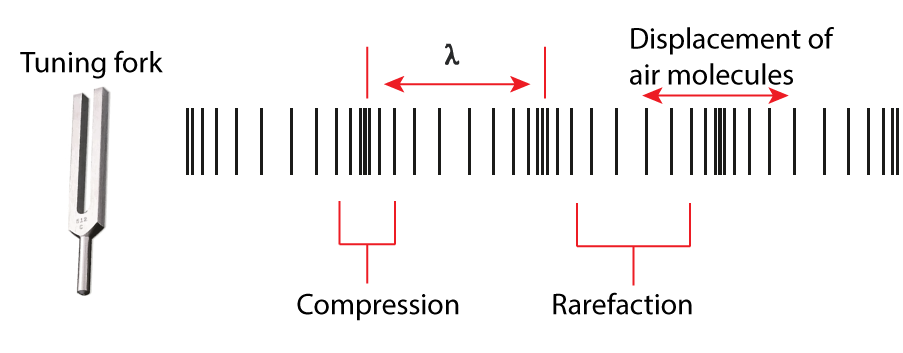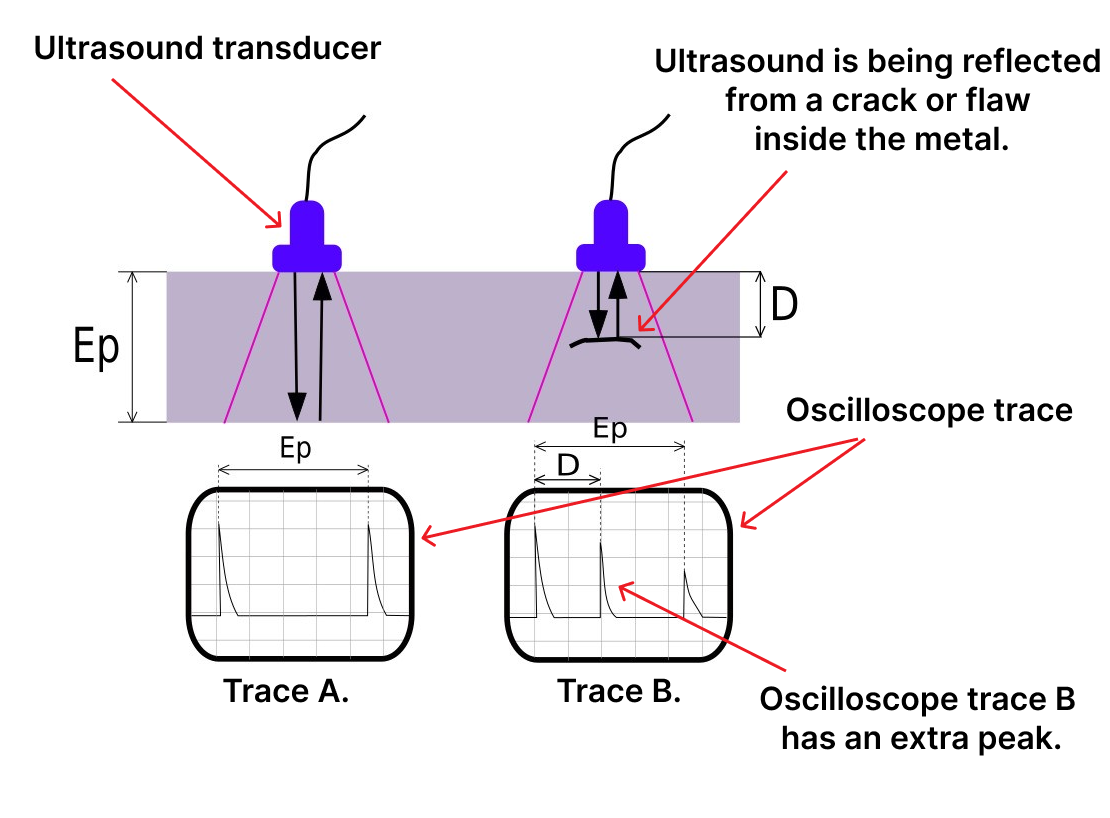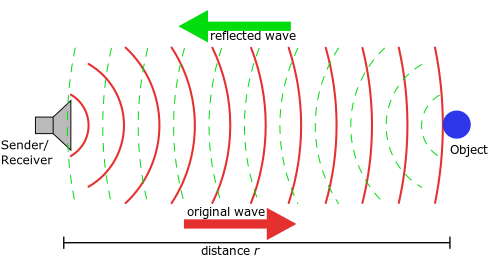3.4 Sound
1. Production of Sound by Vibrating Sources
- Sound is produced when an object vibrates, creating compressions and rarefactions in the surrounding medium (e.g., air, water, or solids).
- Example: A guitar string vibrates when plucked, causing the surrounding air particles to vibrate and produce sound.
2. Longitudinal Nature of Sound Waves

- Sound waves are longitudinal waves, meaning the vibrations of particles in the medium move parallel to the direction of wave propagation.
- These waves consist of alternating compressions (where particles are close together) and rarefactions (where particles are spread apart).
3. Audible Range of Frequencies for Humans
- Humans can generally hear sounds within the frequency range of 20 Hz to 20,000 Hz (20 kHz).
- Sounds below 20 Hz are called infrasound, and sounds above 20 kHz are called ultrasound.
Examples:
- Infrasound (< 20 Hz): Earthquakes (around 0.1 to 10 Hz), elephants’ low-frequency sounds (around 5 to 10 Hz).
- Audible Range (20 Hz – 20,000 Hz):
- 20 Hz – 100 Hz: Deep bass sounds (e.g., subwoofer output).
- 100 Hz – 1 kHz: Speech and general music range (e.g., low-pitched voices around 100 Hz).
- 1 kHz – 5 kHz: Most speech and musical instruments fall here.
- 5 kHz – 20 kHz: High-pitched sounds, like crickets (around 10 kHz), or the highest notes on a piano.
- Ultrasound (> 20,000 Hz): Dog whistles (around 30 kHz), medical ultrasound (1-10 MHz).
4. Medium for Transmitting Sound Waves
- Sound requires a medium (such as air, water, or solids) to travel through. It cannot travel in a vacuum because there are no particles to carry the vibrations.

Sound needs a medium (material) to travel, which can be shown in an experiment using a bell in a glass jar. When the battery is connected, the bell can be seen and heard as vibrations pass through the air in the jar, then through the glass, and finally through the air outside to reach our ears. However, when the air is pumped out, the bell is still visible but no longer audible, demonstrating that sound cannot travel in a vacuum.
Despite the Sun’s powerful explosions and solar flares, we hear no sound from it due to the absence of particles in space to carry these disturbances. Light waves, unlike sound, can travel through a vacuum, allowing us to see the Sun.
A major difference between sound and light waves is their speed: light travels at about 300,000,000 m/s, nearly a million times faster than sound. This is why we see lightning almost immediately but hear thunder moments later.
Examples of Sound Speed in Different Mediums
- Air: 343 m/s at room temperature
- Water: ~1,480 m/s
- Solids:
- Steel: ~5,960 m/s
- Glass: ~5,200 m/s
- Wood: ~3,850 m/s
5. Speed of Sound in Air
- The speed of sound in air is approximately 330–350 m/s, depending on factors like temperature, humidity, and air pressure.
- At room temperature (20°C), the speed of sound is about 343 m/s.
6. Method to Determine Speed of Sound in Air

To measure the speed of sound in air, use a method that involves measuring the time it takes for sound to travel a known distance.
- Stand at least 50 meters from a large, flat wall and bang two wooden blocks together to create an echo.
- Adjust the rhythm so that each clap aligns with the echo of the previous bang; this may take some practice.
- Have a partner measure the time taken for 20 bangs.
- Record both the time for 20 bangs and the distance to the wall.
- Calculate the total distance traveled by sound, as each bang covers a round trip to the wall and back. Use the formula:
- Total distance = 20 x 2 x distance to the wall
- Calculate the speed of sound in air with:
$$Speed={{Distance}\over{time}}$$
7. Amplitude and Frequency: Effects on Loudness and Pitch
Amplitude: the greatest height or depth of a wave from its undisturbed position.
Frequency: the number of complete vibrations or waves per unit time
- Amplitude: Affects the loudness of the sound.
- Higher amplitude = louder sound.
- Lower amplitude = quieter sound.
- Frequency: Affects the pitch of the sound.
- Higher frequency = higher pitch.
- Lower frequency = lower pitch.
Example 01:
The oscilloscope can be used to calculate the frequesncy of a wave

- Each division on the X-axis represents 20 ms (0.02 seconds).
- The red dashed line marks one wave period (T), which spans two divisions, equivalent to 0.04 seconds.
This visual aids in calculating frequency, with one wave cycle completing in 0.04 seconds, resulting in a frequency of:
$$Frequency={{1}\over{time}}$$
$$Frequency={{1}\over{0.04}}=25Hz$$
8. Echo: Reflection of Sound Waves
- An echo occurs when sound waves reflect off a surface and return to the listener.
- Example: Yelling near a large wall or cliff and hearing your voice bounce back to you after a brief delay.

9. Ultrasound Definition
- Ultrasound refers to sound waves with a frequency higher than 20 kHz.
- These are beyond the range of human hearing (which is up to 20 kHz).
Supplement
10. Compression and Rarefaction
- Compression: A region where particles are close together in a sound wave, corresponding to high pressure.
- Rarefaction: A region where particles are spread apart in a sound wave, corresponding to low pressure.
- These two regions alternate as the sound wave travels through a medium.
11. Speed of Sound in Different Media
- In general, sound travels:
- Faster in solids (because particles are closely packed and can transfer vibrations quickly),
- Slower in liquids than in solids, but still faster than in gases,
- Slowest in gases (like air), where particles are farther apart and transfer vibrations less efficiently.
12. Uses of Ultrasound
- Non-destructive Testing (NDT):
- Ultrasound is used to check for cracks or defects in materials without damaging them.
- High-frequency sound waves are sent into the material. Reflections from cracks or flaws are detected and analyzed.

- Medical Scanning of Soft Tissues:
- Ultrasound is used in medicine for imaging soft tissues, such as in pregnancy scans or muscle imaging.
- High-frequency sound waves are sent into the body, and the reflections from tissues are used to create images.

- Sonar (Sound Navigation and Ranging):
- Used to detect objects underwater and measure distances (e.g., depth of the sea or location of objects like submarines).
- A pulse of ultrasound is sent out, and the time taken for the echo to return is used to calculate the distance:
- The division by 2 accounts for the round trip (there and back) of the sound wave.

Example 02:
A ship sends out an ultrasound pulse and receives the echo after 3.5 seconds. The speed of sound in water is 1450 m/s. Calculate the depth of the water.
Step 1: Calculate the distance travelled by the pulse:
distance = speed x time = 1450 m/s x 3.5s = 5075m
Step 2: Halve this to get the depth. Remember the pulse goes down and back up again.
depth = 5075m/2 = 2537.5m
Answer
The depth of the water is 2537.5 m.
